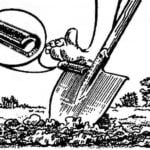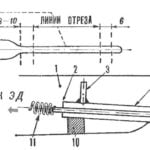The large family of pedal boats has been replenished with another interesting machine, designed by our reader – engineer G. Ovchinnikov from Dnipro. Ovchinnikov is a car enthusiast. Therefore, his main task was to create a pedal boat that could be transported on the roof rack of a passenger car.
The bicycle catamaran is assembled from two hollow floats, each having a length of 3000 mm, a width of 200 and a height of 250 mm. The floats are connected to each other by a bridge made of duralumin corners 30X30 mm (cross members) and 20X20 (longitudinal connections), riveted into one piece. The bridge is equipped with a driver’s seat 7, foot drive pedals 4, a chain drive with an intermediate sprocket (node 3) and a propeller – a paddle wheel (node 4) with six plates (blades), covered on top with a metal casing. To control the rudders 13, a handle 6 is installed under the driver’s left hand. By moving the handle “pull” the catamaran turns to the right, and by moving it “pull” – to the left. The large area of interconnected rudders makes the catamaran very maneuverable.
The floats have a frame of nine rectangular frame frames (they can be made of either wood or aluminum corner) and four longitudinal elements (stringers) located at the corners of the frame frames. The floats at the front and rear end in straight stems. The frame is so simple in design that it can be assembled even without a slipway, on a flat floor or a large table. The cladding (if the frame is metal) must be made of light alloy sheet material. It is installed with rivets, with a sealing tape laid along the seam (in the absence of a special tape, you can use household cotton tape coated with thick oil paint). First the bottom is riveted, then the sides. After this, the inside of the float must be puttied along the seams and painted. Lastly, the deck is installed on M5 screws with countersunk heads (near the inspection hatches, where you can stick your hand inside, the deck should be riveted).

1 – deck, 2 – side stringer, 3 – frame frame beam, 4 – drive sprocket with pedals, 5 – drive chain, 6 – rudder control handle, 7 – driver’s seat, 8 – seat back brace, 9 – paddle wheel casing, 10 — longitudinal tie rod, 11 — steering head, 12 — transverse tie rod, 13 — steering wheel.
After cleaning, the finished floats are carefully puttied along the seams and painted in the desired color. Before painting, the metal surface must be degreased and treated with fine sandpaper.
In the case of making floats from wood, the frame frames are assembled from 35X15 mm pine bars on gussets. Longitudinal stringers made of pine with a cross-section of 20X20 mm can be attached to the frames with screws or strong nylon threads with epoxy glue. The latter method is very simple and does not weaken the structure at all, besides providing some weight savings.

node 1 – fastening the pedal pylon to the bridge, node 2 – cut along the axis of the pedals, node 3 – cut along the axis of the intermediate carriage, node 4 – cut along the axis of the paddle wheel.
The covering of the wooden frame is made of three-layer plywood with a thickness of 2 – 3 mm, with epoxy or casein glue. The direction of the layers of the “shirt” is longitudinal along the bottom and sides, transverse along the deck. The plywood is pressed into the fold with thin nails and 15X2.5 mm screws.
The finished float is carefully cleaned and covered with one layer of fiberglass with epoxy resin. If these materials are not available, you can use regular cotton calico and glue it with nitro glue. Before pasting, all corners and edges of the float body must be slightly rounded with a hog file so that the fabric does not rub off longer during operation.

1 — frame frame of the float, 2 — transverse connection (angle 30×30), 3 — longitudinal connection (angle 20×20), 4 — T-shaped spars.

1 – float, 2 – propeller wheel casing, 3 – propeller wheel plate (blade), 4 – drum axis, 5 – driven sprocket.
As practice has shown, the Malek bicycle catamaran is especially convenient for fishermen and hunters: it is very stable, easily passes through dense thickets of aquatic plants, is completely silent and unnoticeable on the water. You can use it to make long casts with a spinning rod, fish with float rods, jigs and mugs. “Malek” is transported on a standard, industry-produced roof rack. To do this, a wooden frame is installed on it with pads made of foam rubber or porous rubber, on which the bicycle rests with the bottoms of the floats. The Malka is attached to the trunk using hooks with gramophone-type fasteners. This design allows two people to easily install and remove it from the trunk. To prevent unnecessary air resistance during transportation, the driver’s seat is removable and the control handle is foldable.
When building a Malek bicycle catamaran, you can make most of the metal parts yourself or use some standard bicycle parts that are sold in stores.
G. OVCHINNIKOV, engineer, Dnipro



